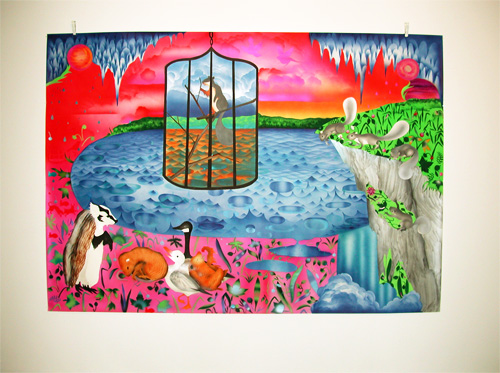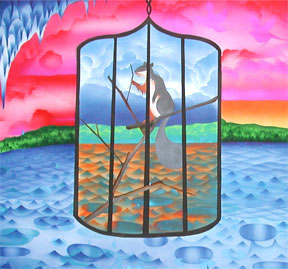
(You can see a bigger version on my website here.)
The work in this show revolves around ideas of romanticism and decorative beauty. The title refers to an actual breed of squirrel that lives in a cage at the Philadelphia Zoo that is very similar to the one pictured in the piece. Prevost’s Squirrels are tricolored, comparatively decorative squirrels. I was struck by the situation of the Prevost’s Squirrel at the zoo because the Philadelphia Zoo has a huge population of common grey squirrels who run freely around the grounds. My reason for using this situation as a metaphor had to do with some ideas I’ve been dealing with in art for a long time now. I’m interested in the ways that we classify beauty: I want to know why some kinds of beautiful things are pretty, some are decorative, and some are ornamental.
I’m suspicious of the impulse to classify kinds of beauty, and I suspect that the ways that we associate certain kinds of aesthetics with silliness has a lot to do with our awareness of the amoral power of aesthetics. It strikes me as rather Victorian that it’s common to insult a painting by calling it decorative: the insult implies that the beauty in the piece is not aspiring to some higher good, as if it has to justify its prettiness by being somehow pure.
I have a real love/hate relationship with the traditions of romanticism, and my visual language comes out of that ambivalence. River is my take on the Preraphaelites: there’s a badger Ophelia on the left, and a pile of narcissistic red-headed bears on the right, one of whom is lifting her skirt. Conflict is a painting about the more common, sinister interpretation of decoration as a symbol of social or capitalist excess. I use lots of decorative, ornamental, girly and popular culture visual strategies in order to make work that’s very accessible and viscerally appealing. I try to attract the viewer to the work in order to play out narratives about power and romanticism.
I use animals because I think they highlight the unnaturalness of the way that we have associated decorative imagery with femininity. The big dresses I use in lots of my work have a particularly feminine history, but I don’t want them to be able to subsume the character of the person inside them: making animals wear big dresses is a way of not allowing the stories I tell to be about individuals. We generalize animals, and I’d like to be able to generalize about the associations between decoration, femininity and fertility. It’s also a way to offset all the assumptions people have about images like flowers and pink bows with a sense of fierceness. I haven’t come to any conclusions about the ways these issues interact, but I know that working with animals in a natural setting makes sense when I’m talking about the history of decoration and femininity; the girliest thing a woman can do is wear a flowered dress, and the most fertile symbol in nature is arguably a flower.

3 comments:
your writing about your art--especially the whys and wherefores of animals in big dresses--really makes me happy. because it's true. though you would never know it from my livejournal, i'm interested in art. and thought. and look forward to reading more here (especially the day you announce that yes! you are accepting commissions for goat portraits and the like!)
this is raccoonpower. my other name is carolyn.
Thanks! That's so nice to hear! And of course you are interested in art- you have a deep understanding of the metaphorical implications of racoons, how could you not be?
Samantha, your art work IS pure and decorative and just simply....very good. no need to clasify it. most people interested in art, would know.
thanks for your participation.
Moti Hasson
Moti Hasson Gallery
Post a Comment